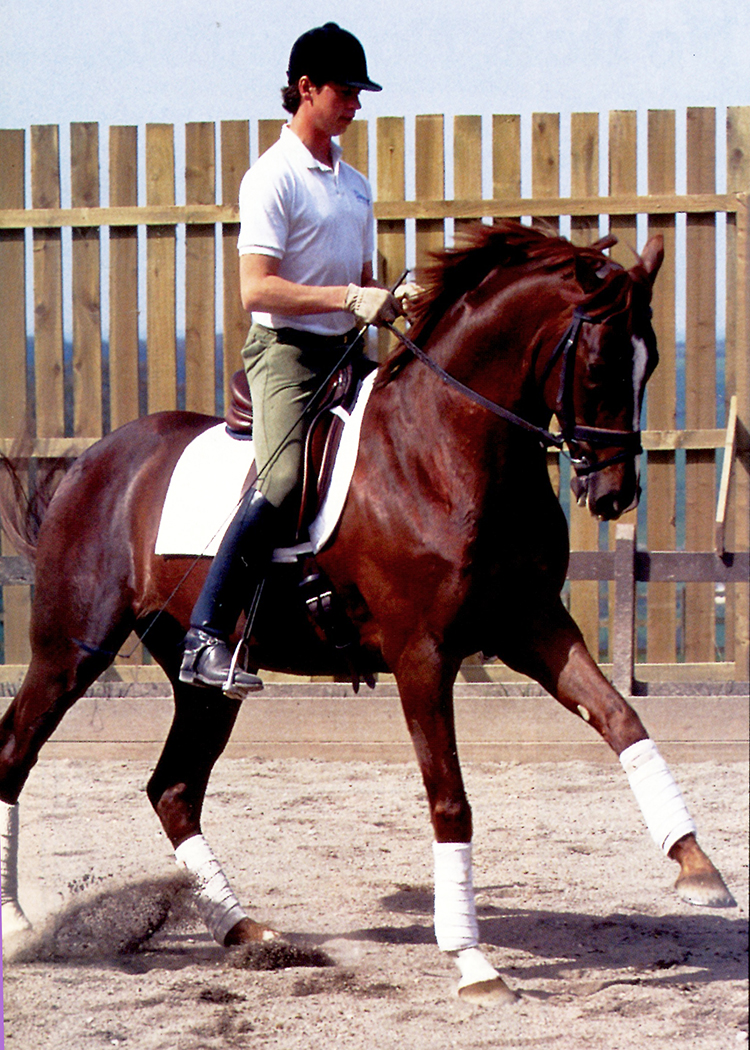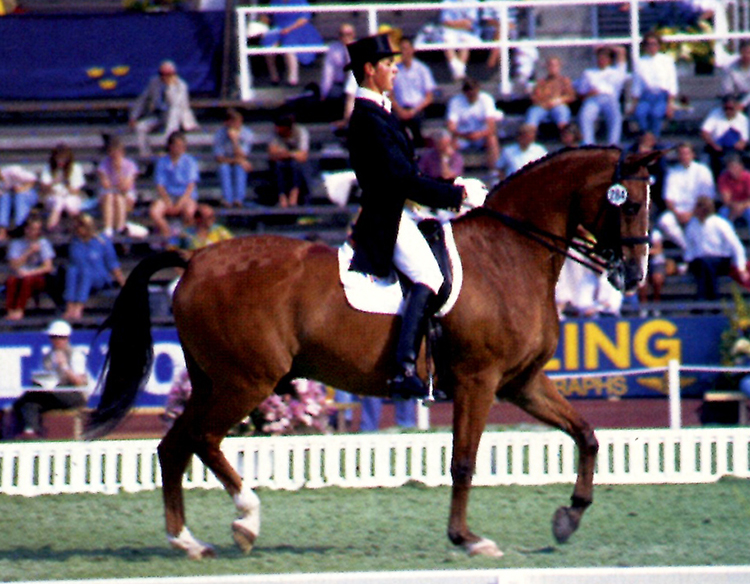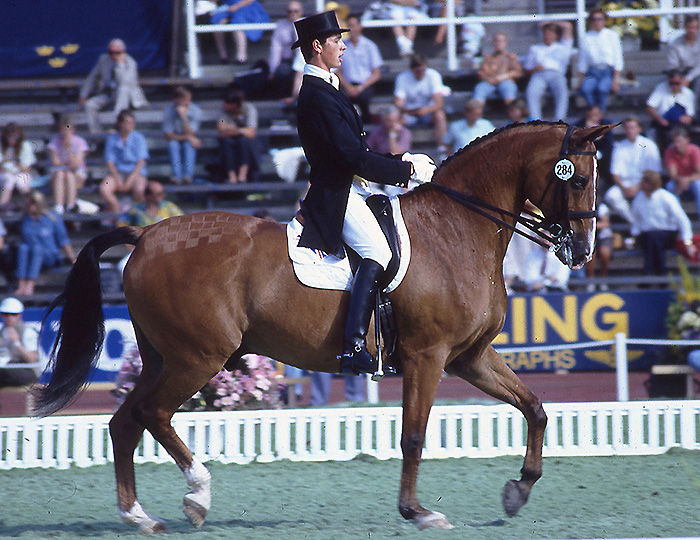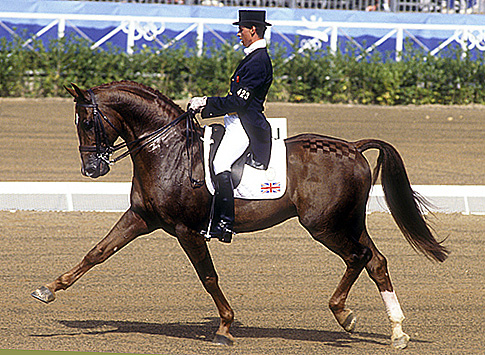 Carl Hester talks to Bernadette Faurie
Carl Hester talks to Bernadette Faurie
It was never difficult for Carl Hester to get talked about. Firstly it was the boy from Sark who learned to ride bareback on the horses used to drive tourists round the tiny car-free Channel Island. Then there was the success on a series of horses at Young Rider level (although Carl unfortunately missed his team slot when he broke his leg the week before the championships) and the production of some useful young event horses, who have all gone to advanced level.
After landing the opportunity of a lifetime riding for the Bechtolsheimers, the German born Gloucestershire based couple who had the most elite string of advanced dressage horses in England, the spotlight was then on Carl as the youngest rider to represent Britain at the Stockholm World Equestrian Games in 1990, the youngest dressage Olympian in Barcelona (and the highest placed of the squad) and the winner of a host of national championships.
Carl and Rubelit von Unkenruf in 1990 at the first WEG in Stockholm
Now, at twenty nine, Carl has been ‘on his own’ for three years as a rider and trainer, based at Kate Carter’s Stow-on-the-Wold yard. In great demand as a trainer- the Kiwis pipped the Aussies to the post in securing him as Olympic team coach – Hester also has a good string of young horses. Since striking out solo, Carl has built up an impressive track record with a string of wins from advanced to Prix St Georges.
Carl and Giorgione at the Barcelona Games
Dr Bechtolsheimer, meanwhile, has taken over the riding of his and wife Ursula’s string of top notch imports, including Carl’s Olympic mount Giorgione who was named second reserve for Atlanta after Dr B traded his German passport for a British one earlier this year.
So why give up an almost unlimited supply of international rides, a full time well paid job as a rider and all the accoutrements of working for very financially favoured people – popping over to Rehbein’s with a shopping list in the private jet, the five-star hotels, the list is endless. At the time, Carl came in for substantial criticism from some members of the dressage establishment for leaving what they perceived to be the job of a lifetime. But it was their predictions that faded into insignificance, while Carl has flourished.
Among Carl’s string this year is Donnersong home bred by Kate Carter six years ago and proudly owned by her mother Patricia Masek. By the great Donnerhall out of a Pik Trumf mare that Kate spotted as a three-year-old, ‘Otto’ made his competitive debut this year and recently won the Advanced Medium Championship at Addington.
As a teacher, Carl is in such demand that some new enquirers are stunned to be told there is a three month waiting list. He says: “I will only take on as much as I can do without losing concentration, it is only fair. Plus I have a good string this year and I have to feel I have the time to give them.”
Star pupil must be World Champion Vaughn Jefferis, who started training with Carl six months before his success in The Hague. Carl is also a member of the Dressage Committee Training Committee, where a particular interest is the new ‘training for young trainers scheme’, and one of the British Young Rider Dressage Scheme trainers.
It was this interest in training others that was the final catalyst in Carl’s decision to break away from the Bechtolsheimers. He recalls: “I have always enjoyed teaching and realistically, you cannot make a living from being a rider in this country. I felt I had to start ‘laying down for the future’ but they were my bosses and they said no.
There was also the gut feeling that, despite the huge opportunities both in the past and the future, Carl had reached the end of the road at that stage in his development as a rider. “I will always be grateful to the Bechtolsheimers for the opportunities they put my way and I missed working with Dr B for a long time, but there was also a lot of pressure to do it their way, which is fine, the horses were theirs. I got a lot of international exposure, not just competitively but to other riders and trainers. Eventually it became difficult to remain ‘spoon fed’ when there was so much food for thought around me.”
Tracey Foster, a BHSI who is now a freelance teacher and trainer of several three-day event combinations, was the Bechtolsheimers’ highly efficient Stable Manager for much of the time Carl was there. She now comes over once a week to be his ‘eyes on the ground’. Tracey explains it: “Carl lasted so long because of his laid back temperament. I can fully understand the situation because I was in it. Carl learnt a lot and achieved a lot, for that he should and does give Dr B a lot of credit, but he is very naturally talented – this was surely why they initially approached him – which as he matured in his riding naturally was expressed in his work. He was developing his own ideas and I feel that the Bechtolsheimers wanted him to stay as he was, in that raw trainable state, and it couldn’t happen. If the Bechtolsheimers had been able to develop the relationship in a different way, it could have been a medal winning team. Also, if Carl had been lucky enough to have a Grand Prix horse, he would have been riding in Atlanta, but his day will come, I am sure of it, because of his talent and personality.

Carl and Rubelit von Unkenruf competing at Stockholm in 1990
The ‘divorce’ happened just before Badminton. Carl went to watch the event to take his mind off things only to be descended on by several dressage worthies bearing instructions not to talk to the press. Dr B, meanwhile, had issued a rather scathing press release. The dressage worthies did not get their way and Carl was whisked into the press tent and surrounded by ‘dailies’ before you could say ‘rein back’. Carl recalls: “I was really grateful and touched that the equestrian journalists were so positive and interested in my future. They treated me in the same way as they treat any sportsman, not as a sort of ‘naughty boy’.”
Jenny McArthur, equestrian correspondent for The Times, comments on that: “Not only had Carl been extremely successful, but he is fun, original and a breath of fresh air. I think we were just worried about who we could find to write about in dressage!”
Carl definitely had no regrets: “At the time, I did find it hard that some people who don’t really understand the sport were so ready to give their own negative opinion, but I’ve got a pretty broad back and I think a lot of it was that they were afraid they would miss out on the Bechtolsheimer’s hospitality, which was always very generous. It was also hard to pack my bags and leave the horses I had grown to love behind. It was a bit daunting starting over, but the fact that Kate offered me her place as a base made it a lot easier. I have known Kate a long time, in fact it was thanks to her letting me ride her horse Billy Can that I got a foothold in Young Riders, so it was really like coming home after leaving boarding school.”
Now that Carl has had time to develop his own routine and philosophy, the ‘Hester’ way is firmly established. He explains it, starting with yard management – “The yard here is designed so that all the horses can see each other, they are not isolated. There are very clear relationships between them. For example, when one comes home from a competition, there’ll be a neigh of ‘Hi guys I’m back’ and all the others will either answer or come to their doors to see what’s been going on.”
“Also, the yard is planned so that we have a tacking up area and wash box in a separate half of the yard. I think it important for them that they have their ‘bedrooms’ away from the bustle of the day where they can relax and have their own space. Once they are brought out they know they are going to work. All the grooming, trimming and any attention is done in the special area, so they are never bothered by us once they are in their ‘boudoirs’.”
“I am very careful to make sure that all the horses, whatever their temperaments, get mental breaks. They are not ‘drilled’ horses. I want them to be able to put the maximum expression into their work, and for that to happen you have to allow it. Every single horse here is turned out. We have four stallions and that includes them. Sure they have to be treated with care, but I believe they should be treated as normally as possible and I don’t make too big a deal of it. Commonsense deals with most of it, such as leading them on a lunge line and bit, not just a headcollar and rope and wearing gloves. This is what I tell the girls. Jo, my working pupil, took a short cut once with one of the stallions and skinned her hand – I’m afraid I wasn’t very sympathetic!”
“When they go to competitions they have to be around other horses so it has to start at home. The stallions never go out in adjacent paddocks obviously, it is not worth the risk, but they do live next door to each other.”
“They all go hacking on Sunday. We take them down to the river at Lower Slaughter to let them play in the water and the ones that aren’t safe on the roads at least go round the fields. We are lucky in that we can go straight out of the yard onto fields – as long as we keep to the edge and don’t upset the farmer. They all enjoy going in the water. When I have a new resident who has never done it before. I have to be prepared to spend a while down there. We will take a newcomer with a horse who has been before, but once they are in, they love going back. I do jump them sometimes – if I don’t feel too lazy to get the wings and poles out – but it is not a necessity as long as they get their breaks in other ways.”

Carl on Training: “Each horse is an individual. Most are up to a fairly good level for their age, but what develops first depends on their particular talent. For example a youngster with good trot work will have a go at passage quite quickly and one a good canter will be asked first for changes. If you capitalise on their talents, they can take on new lessons in confidence and you get the best they can do. I do allow them the freedom to have ‘a buck and a fart’ if they have done well, it is incredibly important. Of course there is a stopping point, but it is too easy to whack and pull them, be dominant and never allow them to be disobedient. Think like this though, and how on earth can you then expect them to be expressive?”
Kate Carter comments: “There is no one else I would have given Donnersong to. If Carl had not been available, I would have had him gelded and ridden him myself. As far as I am concerned, there is no one who is a patch on Carl as a rider or trainer in this country. We want to produce Donnersong to the utmost of his ability, then if he is as successful as we all hope. I will feel he is qualified to stand at stud and be an asset to British breeding. Donnersong (‘Otto’) is a lovely horse with a smashing temperament, but he is only developing as such a super character because of the way he is being brought up.”
Carl’s own training: ‘Tracey, who worked with me at the Bechtolsheimers, comes over once a week to work with me and teach the girls, where she concentrates on their position and correctness. Tracey has a fantastic eye and the gift of being able to put into words, quickly, what she sees. Everyone working on their own will develop little position faults. Tracey has a razor sharp eye for that and keeps me in place. When I am on my own, I tend to concentrate on the basic work because that one day a week when Tracey is there, is the real ‘asking’ day for the horses, they’ll get quite a vigorous work out. Tracey works with me a lot from the ground, for example in piaffe and passage work, which is a strenuous exercise for the horses and for that day, we will ask them to give that little bit more.
“Their general workout is based around stretching, bending, straightening and suppling to develop looseness. This applies whether they are babies or advanced and they get plenty of breaks during their sessions. You have to be constantly aware that with any kind of athletic training, be it people or horses, working tired muscles leads to strain.”
“The horses know when they are up ‘on the bit’ they will be asked for ‘proper’ corners, accurate circles and so on, so there is no confusion. It is like dancers – they warm up at the bar then produce the set manoeuvres in the performance.”
“It is also vital for me, being away teaching or competing so much, that I have someone who keeps the horses in tune. Jo Barry, who was on the European Pony team a few years ago, has been with me since the beginning of the year. When I am away, her job is to work on the relaxation and suppleness, such as riding them forward and back, alternately stretching and collecting and doing plenty of leg yielding, never the test movements. Kate is also doing some more riding now that her twin boys are a year old and she has a little more time, which is another help. I was away in Jersey for a week recently and she really enjoyed keeping Otto going, once I had persuaded her that he would be fine! I use a lot of leg yielding – I love it. It is an exercise everyone should do and in my opinion, it should be included in novice tests. I use it as soon as the horse is able to go straight and there is nothing like it for getting the horse to be supple, let go in himself and go off the rider’s leg with confidence. It is a complete fallacy that if you teach leg yield it is hard to do half pass, but a lot of people seem to think that. If the horse is really supple and able to flex. asking for the half pass bend is simply not a problem.”
Carl has a tremendous reputation as an accurate test rider and for having one of the coolest heads in the business. As one colleague, who asked not be named ‘as he would never hear the end of it!’ explained: “Carl in competition is a fiend. At one winter competition I beat him in the first test. Carl was joking around saying ‘Just wait, baby wants a winner’s rosette’. But it isn’t a joke, you know when he has decided he is in winning mode he can get a test out of a donkey. It is quite intimidating.”
Carl: “Well, I did not have someone watching me on six horses a day for three years (at Dr B’s) without learning how to ride tests I Things like how a circle should be ridden are ingrained in me. Having Dr B’s eyes on the ground, it was a question of if it is not straight, if it is not a proper corner, if the half pass is not finished properly, do it again until it is. There was no point in a half-hearted attempt. Now it is the same for my working pupils, at home and if they are riding tests in competition.”
“As for nerves, I would say I get ‘keyed up’ rather than nervous. I am a bit of a showman, I love it and after all, the whole purpose of being at a show is to do your best, and do the best by your horse, in the few minutes you are in the ring .”
Carl has taken a lot of stick for not appearing to take life seriously enough, but it is this apparently ‘happy go lucky’ attitude that is such a strength.
Tracey comments: “Carl has matured, he has had to, he has thought about the ‘haws and whys’ and has worked out a long range plan for each particular horse. He is a joker and always will be, but he has become so much stronger in his ability to correct anything on any horse because he has been free to use what he always had inside – his incredible natural feel.”
For another of Carl’s owners, Judy Harvey, a fellow of the BHS, International candidate judge and member of the dressage committee, it was a big decision to hand over Korsar, the horse she had produced from a three year old to Prix St Georges, to another rider.
She says: “Basically Carl rides in such a good balance and has such feel, he can give the horse total confidence. Carl is the rare type that flourishes under competitive pressure, but the main thing for me is that he loves horses. It is obvious in his training, handling and the atmosphere around him. They have to do the job, but they are loved and respected at the same time. Carl has to be the best rider England has ever seen. The bottom line is, he’s a horseman. In relation to the rest of the world he has to be one of the best. If he had the support and the horses of someone like Isabell Werth, I’ve no doubt he’d do as well.”
The first to agree with that is the World and European champion herself. Isabell Werth got to know Carl on the circuit basically because they have the same capacity for spontaneous laughter. Says Isabell: “I think it was a shame for Britain when Carl was no longer riding the Bechtolsheimer horses and I hope he has a Grand Prix horse soon. He is the British rider we all respect. With myself and Dr Schulten-Baumer, who has fantastic experience and knowledge, that I can talk to him, and discuss, is so important and, if that were not possible, it would not work. When we were at the same shows I had the feeling it was not like this for Carl.”
Meanwhile, the dust has settled on the debris of the Bechtolsheimer/Hester parting. Dr and Mrs Bechtolsheimer have expressed their pleasure that Carl has some good young horses coming up, while Carl is delighted to hear news of Giorgione’s offspring – his first crop of foals touched the ground this year and look to have been stamped with ‘Gino’s nobility’.
For Carl, a recent sponsorship deal with Brick Court Chambers, a top London firm of Barristers, has given a much needed boost to the coffers. It covers Democrat and Jaguar, who’ll now be known as Legal Democrat and Legal Jaguar respectively.
Carl says: “This sponsorship is so valuable. For Democrat’s owner Marcia it will be a great help. She is committed to seeing us get to Grand Prix, but the finances are difficult and Jaguar, I think, has a great future. Democrat exercised his new ‘legal’ name at Wembley CDI-W, where I was thrilled with his wins. There are some other sponsorship possibilities in the pipeline so I am more than happy that people have such faith in me. I have a good string of horses, a lot of support and I’m looking at a great future.”
This article first appeared in the December 1996 issue of THM.




